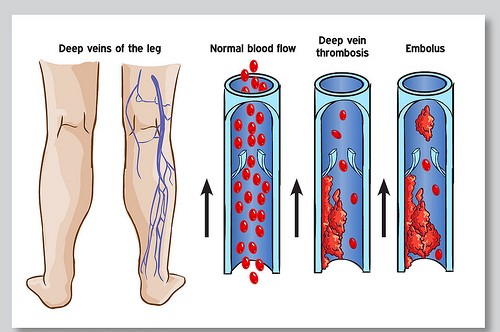
What Is Deep Vein Thrombosis?
Deep vein thrombosis (DVT) is the presence of a blood clot in the veins, the blood vessels that carry blood back to the heart, in the legs or arms. Coagulated blood can travel back to the lungs or to the heart, where it can cause cessation of breathing or the pumping of blood. Or the blood clot may just stay in the vein in the leg or arm and cause swelling. About a quarter of the people who develop deep vein thrombosis experience pulmonary embolism, a blood clot in the lungs. Deep vein thrombosis sometimes can be diagnosed with ultrasound, but usually diagnosis requires catheterization, sending a tube with a camera into the vein through a tiny cut in a blood vessel.
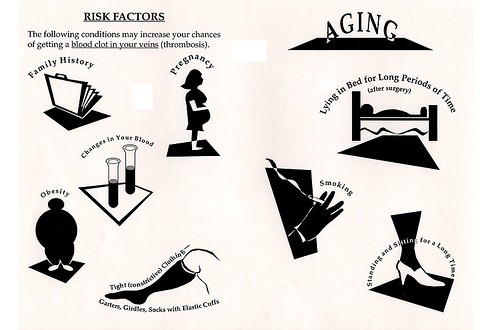
Who's At Risk
The greatest number of deaths from pulmonary emboli (blood clots in the lungs) caused by deep vein thrombosis occur in hospital patients, usually patients who had surgery 1 to 3 days earlier. As many as 12% of all surgery patients and 70% of surgery patients over the age of 70 develop DVT while in the hospital. Among people who aren't in the hospital, about 1 person in 50 has some form of the disease. Anyone who has venous insufficiency of the lower legs, a condition that causes itching, dry skin, and ulceration on the feet, ankles and lower calves should be alert to the signs of the disease.
- Important notification about information and brand names used in this slideshow!
- Photo courtesy of Janice Hechter by Flickr : www.flickr.com/photos/7131866@N04/1949717862/
- Haeger K. Problems of acute deep venous thrombosis. I. The interpretation of signs and symptoms. Angiology. Apr 1969
- 20(4):219-23.
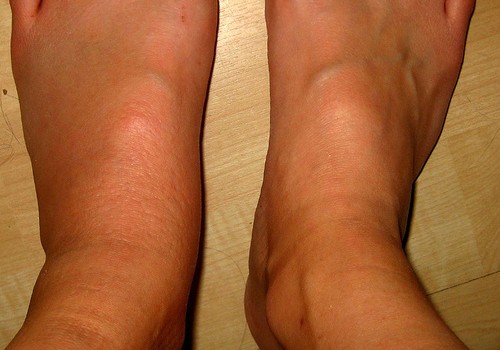
What Are The Symptoms Of DVT?
Deep vein thrombosis is notoriously difficult to diagnose. In about 50,000 cases per year, the first symptom of the condition is death. In other cases, the blood clot in the vein causes excruciating pain and swelling, but in many cases there is no pain and no swelling at all. Even the blood tests for deep vein thrombosis are ambiguous. An elevated d-dimer blood test indicates there may be DVT, but isn't conclusive. Blood clots may not show up on ultrasound, especially if the walls of the blood vessel are strong. Many inexperienced ultrasound techs will read the muscle surrounding the vessel as the wall of the vessel and miss the clot entirely. Blood clots may also be missed by CT scans and x-rays. If you have a negative d-dimer test and negative scans, you may be in the clear, but definitive diagnosis still requires a surgical procedure.
- Important notification about information and brand names used in this slideshow!
- Photo courtesy of Malingering by Flickr : www.flickr.com/photos/malingering/1817283961/
- Tapson VF. Acute pulmonary embolism. N Engl J Med. Mar 6 2008. 358(10):1037-52.

Causes Of DVT
Deep vein thrombosis is essentially a condition of coagulated blood, and blood tends to coagulate when it does not flow. Veins are almost never affected by atherosclerosis; arteries clog but veins don't. When veins don't conduct blood, there has usually been a mechanical injury to the vein. This can be a complication of an injury, surgery, stroke, or even of another DVT. This condition can also occur when people get extremely dehydrated, during cancer, and as a complication of paralysis or having to stay in bed. About 30% of surgeries for cancer are compliated by DVTs, usually appearing a few days to a few weeks after the operation.
- Important notification about information and brand names used in this slideshow!
- Photo courtesy of TRF_Mr_Hyde by Flickr : www.flickr.com/photos/scottchene/7702773622/
- Rickles FR, Levine M, Edwards RL. Hemostatic alterations in cancer patients. Cancer Metastasis Rev. Nov 1992.11(3-4):237-48.

Pregnancy And Deep Vein Thrombosis
Women who have just given birth to their babies are at elevated risk for deep vein thrombosis, although the condition can occur at any time during pregnancy. Typically, DVT during pregnancy causes pain, warmth, and swelling in the calf of just one leg. There may only be pain when standing or walking. If pain or swelling in a leg is followed by sudden difficulty breathing, tightness in the chest, pain in the chest, coughing up blood, or loss of consciousness, it is important to get emergency medical help at a hospital right away. Women who have varicose veins, who are in wheelchairs, or who have relatives who have had DVTs are highest risk for the condition during pregnancy.
- Important notification about information and brand names used in this slideshow!
- Photo courtesy of Thomas Pompernigg by Flickr : www.flickr.com/photos/newlifehotels/3508062243/
- You may also want to see http://www.rcog.org.uk/womens-health/clinical-guidance/venous-thrombosis-pregnancy-and-after-birth.
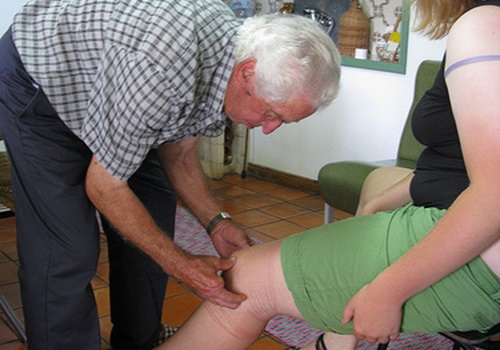
How DVT Is Diagnosed
Deep vein thrombosis can't really be diagnosed without surgically opening up the vein to take a look for a clot. Many people who turn out to have blood clots in the deep veins of their arms and legs, about 50% in fact, never have any pain or swelling at all. Some people have excruciating pain without swelling, and some have extreme swelling without pain. A blood test for a protein called d-dimer may be positive without the actual presence of a clot. When pain is present, it is usually limited to the calves of the legs or the midline of the thigh, but medical testing is always necessary to rule out or confirm DVT.
- Important notification about information and brand names used in this slideshow!
- Photo courtesy of ken anderson by Flickr : www.flickr.com/photos/kenanderson/2729461204/
- Gorman WP, Davis KR, Donnelly R. ABC of arterial and venous disease. Swollen lower limb-1: general assessment and deep vein thrombosis. BMJ. May 27 2000. 320(7247):1453-6.
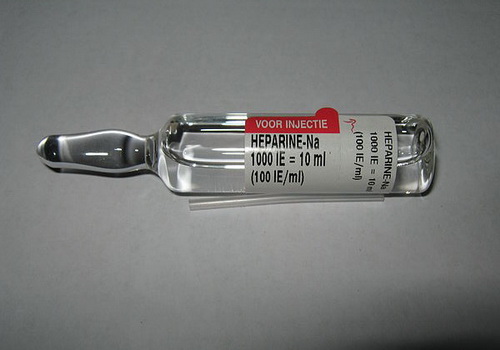
Anticoagulants
Anticoagulants, or blood thinning agents, are used both to break up clots and to keep blood clots from recurring after initial treatment of DVT. There are a variety of anticoagulants on the market today. Some of them such as clopidrogel (Plavix) can be taken without seeing the doctor more often than once every two or three months. Other, older anticoagulants such as warfarin (Coumadin) require regular blood tests and dietary restrictions. The people who are most likely to stay on anticoagulants for six months or longer are those who either have cancer, malignant tumors using blood clots to spread themselves and increasing the risk of DVT in the process, and people who have had stroke.
- Important notification about information and brand names used in this slideshow!
- Photo courtesy of PanaromicTiger by Wikimedia Commons : commons.wikimedia.org/wiki/File:Ampul_Heparine.JPG
- [Best Evidence] Prandoni P, Prins MH, Lensing AW, Ghirarduzzi A, Ageno W, Imberti D, et al. Residual thrombosis on ultrasonography to guide the duration of anticoagulation in patients with deep venous thrombosis: a randomized trial. Ann Intern Med. May 5 2009.150(9):577-85.
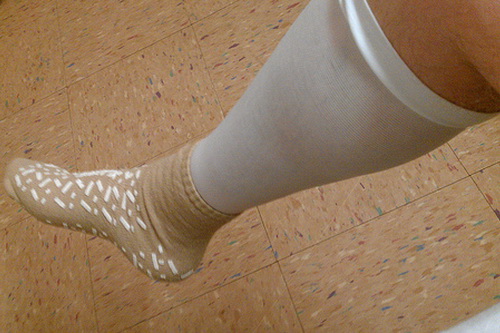
Compression Stockings
Compression stockings, which are basically heavy socks that are so hard to put on that they force blood upward through the veins in the legs, are great for treating varicose veins. They strengthen the muscles around the veins, and they help reduce the pooling of blood that causes the appearnce of ugly varicose veins on the legs. Your doctor may ask you to wear them after you have treatment for DVT--or if you are at risk for a DVT, as when bed rest is required after surgery. The kind of compression stockings used in hospitals don't maintain pressure on the legs or arms all the time. They pump up and release periodically as they are wom. The noise can be annoying, but they are much more comfortable than the kind of stockings you put on yourself.
- Important notification about information and brand names used in this slideshow!
- Photo courtesy of Steven Harris by Flickr : www.flickr.com/photos/srharris/8484679014/
- CLOTS (Clots in Legs Or sTockings after Stroke) Trials Collaboration, Dennis M, Sandercock P, Reid J, Graham C, Forbes J, Murray G. Effectiveness of intermittent pneumatic compression in reduction of risk of deep vein thrombosis in patients who have had a stroke (CLOTS 3): a multicentre randomised controlled trial. Lancet. 2013 Aug 10. 382(9891):516-24. doi: 10.1016/S0140-6736(13)61050-8. Epub 2013 May 31. Erratum in: Lancet. 2013 Sep 21
- 382(9897):1020. Lancet. 2013 Aug 10
- 382(9891):506.
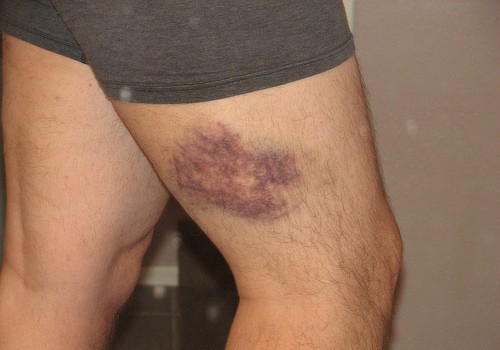
Medication Side Effects
One of the realities of getting treated with anticoagulants (Arixtra, Xarelto), low molecular weight heparin (Lovenox), vitamin K antagonists (Coumadin), or thrombolytics (such as urokinase or streptokinase) is that there will be increased risk of bleeding. If you cut yourself, you will bleed a lot more than usual. It's not unusual for a small cut, even a paper cut, to bleed for an hour. The increased bleeding time means that clots are far less likely to form and there is much lower risk of another DVT. It is extremely important to take medications exactly as prescribed, neither too little nor too much.
- Important notification about information and brand names used in this slideshow!
- Photo courtesy of Jeff / Godfrey by Flickr : www.flickr.com/photos/jeff-godfrey/3472978153/
- Bauer KA, Eriksson BI, Lassen MR, Turpie AG. Fondaparinux compared with enoxaparin for the prevention of venous thromboembolism after elective major knee surgery. N Engl J Med. Nov 1 2001.345(18):1305-10.

Prevention
There is one common situation in which you can take charge over your risk for DVT. That's airline travel. Anytime you have to fly more than three hours without a stop, it is important simply to get up and stretch once in a while. This keeps blood moving through your legs and arms and reduces the risk of your having a DVT during the flight or after you land. If you have surgery, you almost certainly will be fitted with compression stockings. They're not uncomfortable. They even feel a little like getting a massage. But make sure you wear them all the time. Doctors also prescribe "blood thinners" for DVT prevention. They simply have to be taken exactly as prescribed for maximum benefit.
- Important notification about information and brand names used in this slideshow!
- Photo courtesy of Ranch Seeker by Flickr : www.flickr.com/photos/ranchseeker/8675872806/
- Effectiveness of intermittent pneumatic compression in reduction of risk of deep vein thrombosis in patients who have had a stroke (CLOTS 3): a multicentre randomised controlled trial. Lancet. May 31 2013



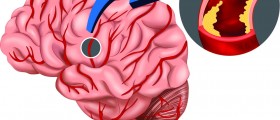




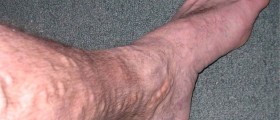









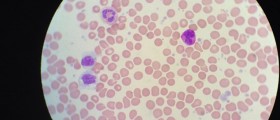
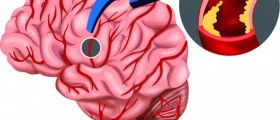
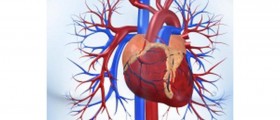




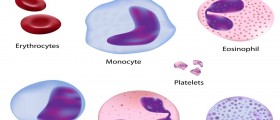
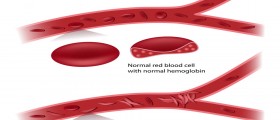
Your thoughts on this
Loading...